As an Amazon Associate KitchenwareSets.com earns from qualifying purchases.
9 Open Floor Plan Kitchen Dining Living Ideas For Small Spaces
Feeling like you’re living in one big, undefined room? You love the idea of an open floor plan kitchen, dining, and living area, but in a small space, it can quickly feel less like a spacious dream and more like a cluttered, chaotic reality. Without walls, where does one zone end and another begin? How do you create a cozy living room when it’s right next to the kitchen sink?
The challenge is real. Decorating a small open-concept space often feels like solving a complex puzzle. You’re fighting the urge for everything to blend into a single, multifunctional mess, struggling to create distinct, purposeful areas for cooking, eating, and relaxing. It’s easy to feel like you have to choose between flow and function, style and sanity.
The key to a successful open floor plan in a small space is to create distinct functional zones for cooking, dining, and living through the strategic use of color, furniture, lighting, and decor without adding physical barriers. This approach maximizes natural light and maintains a sense of spaciousness while bringing order and intention to your layout. By cleverly defining each area, you can make your home feel both larger and more organized.
Feeling Cramped? How to Make Your Small Open Floor Plan Feel Spacious and Chic
An open floor plan in a small home is a brilliant way to maximize every square foot. By removing walls, you instantly create a brighter, more connected living environment. But this openness comes with its own set of design challenges, namely a lack of definition and a tendency for clutter to take over the entire space. The goal isn’t just to live in an open area, but to create a cohesive home where the kitchen, dining, and living areas flow together beautifully while still serving their unique functions.
As someone who has designed and lived in multiple small apartments, I know the challenge is real. These aren’t just theories; they’re proven strategies for creating flow and function where there seems to be none. We’re about to dive into 9 expert-backed, visually inspiring ideas that will transform your cramped quarters into a functional, chic, and spacious-feeling home.
9 Genius Ideas to Define and Elevate Your Open Floor Plan (Updated for 2025)
Ready to take control of your open-concept space? These nine ideas are the fundamental building blocks for a successful small open-plan design. Think of them as your designer’s toolkit for creating separation, cohesion, and style without ever putting up a wall. Each point includes a clear “how-to” guide and a visual prompt to inspire immediate action, proving that you don’t need a massive footprint to have a magnificent home.
1. Create Cohesion with a Unified Color Palette
The most effective way to make separate zones feel connected is by using a unified color palette throughout the entire space. This creates a seamless visual backdrop, preventing the open plan from feeling choppy or disjointed and tricking the eye into seeing it as one large, harmonious area.
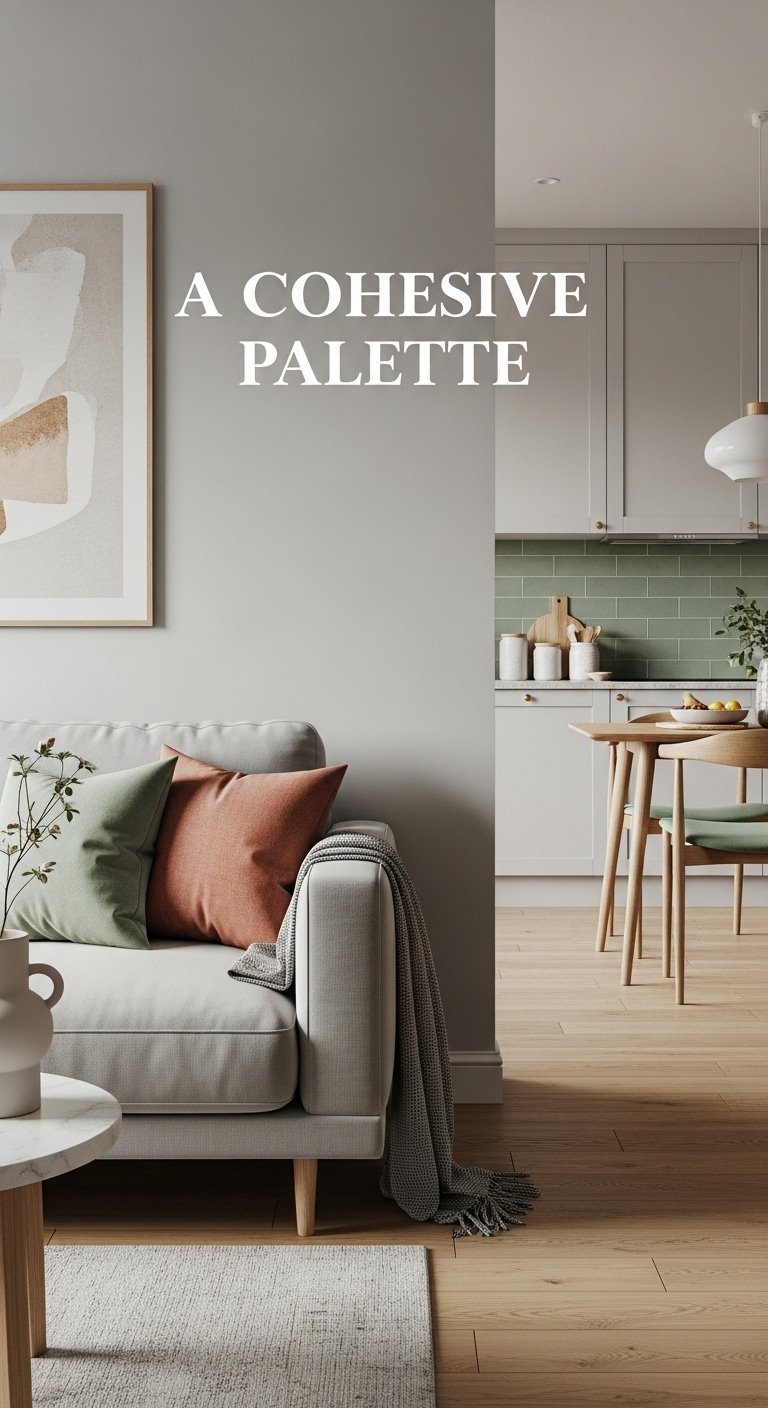
- Materials Needed: 3-4 complementary paint swatches (one base neutral, 2-3 accents), painter’s tape, sample paint pots.
- Step-by-Step Directions:
- Choose Your Base: Select a light, neutral color (like off-white, light gray, or beige) for the majority of the walls. This creates a seamless backdrop.
- Select Your Accent Palette: Pick 2-3 complementary accent colors. These will be used for decor elements like pillows, artwork, rugs, and kitchen accessories.
- Test in Your Space: Paint small test patches of your base color on different walls to see how it looks in your home’s natural light throughout the day.
- Weave Colors Throughout: Distribute your accent colors across all three zones (kitchen, dining, living). A blue vase in the kitchen can echo the blue in the living room rug, creating a visual thread.
Pro-Tip: Use a 60-30-10 color rule. 60% of your space is the dominant neutral, 30% is a secondary color (perhaps on an accent wall or large furniture), and 10% is your pop of accent color in small decor items.
Pin this color palette for your small space makeover!
2. Define Zones with Strategic Rug Placement
To create the feeling of separate “rooms” without walls, use area rugs to anchor your furniture and establish clear visual boundaries. A well-placed rug effectively says, “This is the living room,” or “This is the dining area,” giving each zone a sense of purpose and organization.

- Materials Needed: Measuring tape, area rug(s) correctly sized for your zone(s).
- Step-by-Step Directions:
- Measure Your Zone: Measure the area you want to define, for example, your living room seating area.
- Choose the Right Size: Select a rug large enough so that at least the front legs of all main furniture pieces (sofa, chairs) can sit on it. This anchors the furniture and creates a unified “room.”
- Position the Rug: Place the rug in the center of your desired zone. Arrange the furniture on and around it.
- Coordinate, Don’t Match: If using a second rug (e.g., under the dining table), choose one that complements the first in color or style but isn’t identical. This creates distinction while maintaining harmony.
Lesson Learned: Avoid ‘floating’ rugs that are too small for the furniture group. It makes the space feel disconnected and smaller. When in doubt, go a size up.
Save this rug placement tip to your ‘Living Room Ideas’ board!
3. Anchor the Space with a Multi-Functional Kitchen Island
A kitchen island is the ultimate workhorse in an open floor plan, serving as a natural and highly functional divider between the kitchen and living areas. It provides extra prep space, storage, and a casual dining spot, all while creating a subtle but effective boundary.

- Materials Needed: Measuring tape, painter’s tape, (optional) bar stools.
- Step-by-Step Directions:
- Assess Your Space: Ensure you have at least 36-42 inches of clearance on all sides of where the island will go to allow for comfortable traffic flow.
- Mark the Footprint: Use painter’s tape on the floor to outline the dimensions of a potential island. Live with it for a day to see how it affects your movement.
- Prioritize Function: Choose an island that solves your biggest need. Do you need more storage? Opt for one with cabinets. Need a dining spot? Look for one with an overhang for stools.
- Add Seating: Select backless or low-profile bar stools that can be tucked completely under the counter to save space when not in use.
Pro-Tip: A peninsula attached to a wall is a fantastic alternative for very small or narrow spaces. It offers the same boundary and functionality as an island without requiring clearance on all four sides.
Love island life? Pin this for your dream kitchen!
4. Choose Smart, Double-Duty Furniture
In any small space, every piece of furniture must earn its keep. Opt for multi-functional pieces that offer storage or flexibility to maximize utility and minimize clutter. This smart approach allows you to have all the function you need without crowding your floor plan.
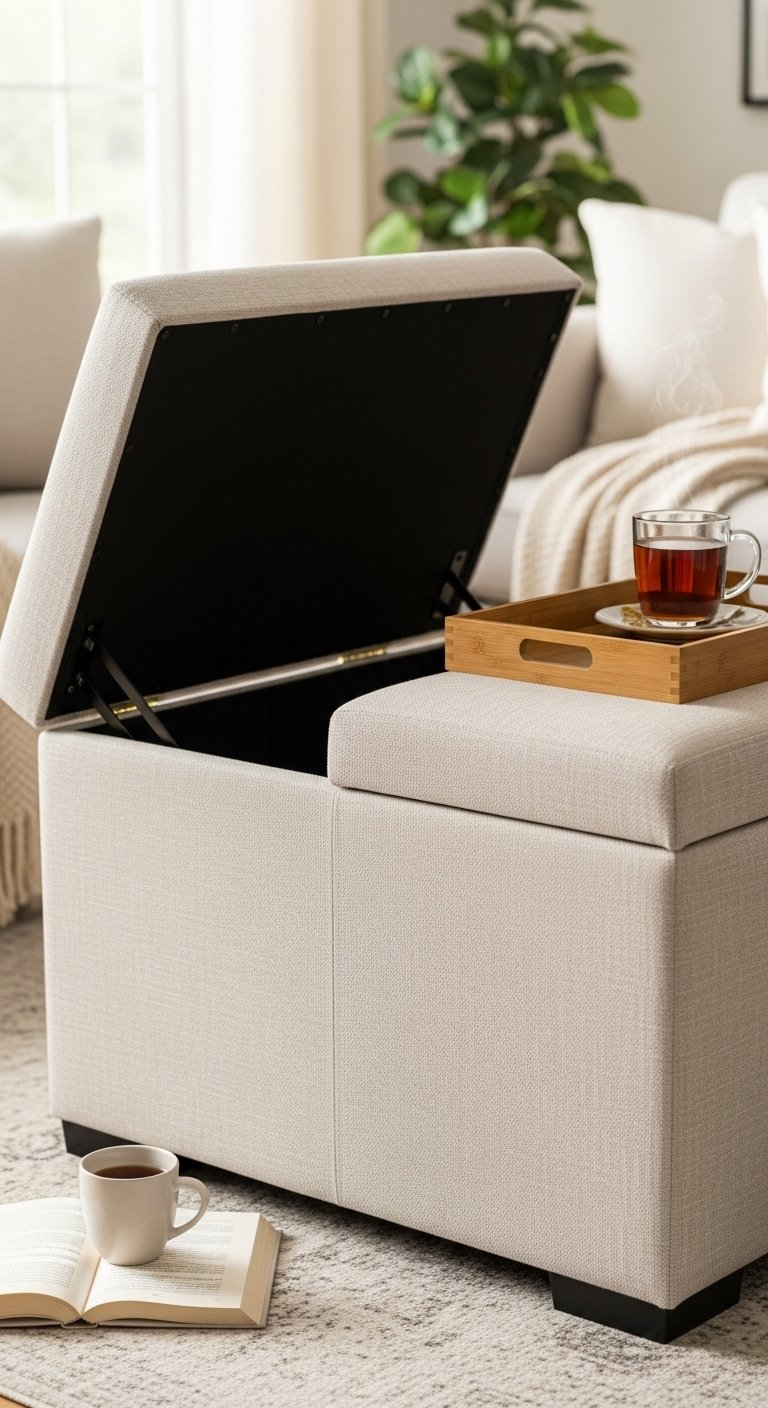
- Materials Needed: A list of your functional needs (e.g., seating, storage, workspace, dining).
- Step-by-Step Directions:
- Conduct a Furniture Audit: Look at each piece of furniture you own or plan to buy. Ask: “Can this do more than one thing?”
- Replace Single-Use Items: Swap a standard coffee table for a storage ottoman (footrest + storage) or a lift-top table (coffee table + desk).
- Embrace Flexibility: For dining, consider a drop-leaf or retractable table that can be small for daily use and expanded for guests.
- Think Hidden Storage: Choose a sofa with a built-in chaise lounge that lifts to reveal hidden storage for blankets and pillows.
Lesson Learned: Before buying any piece of furniture for a small space, measure it twice! And then, use painter’s tape to mark its dimensions on your floor to ensure it won’t overwhelm the room.
Add this genius furniture tips to your ‘Small Home Solutions’ board!
5. Go Vertical to Draw the Eye Upward
To create the illusion of a larger space, utilize vertical space to draw the eye upward. When you make use of your walls all the way to the ceiling, you emphasize the height of the room, which makes the entire floor plan feel more expansive and airy.
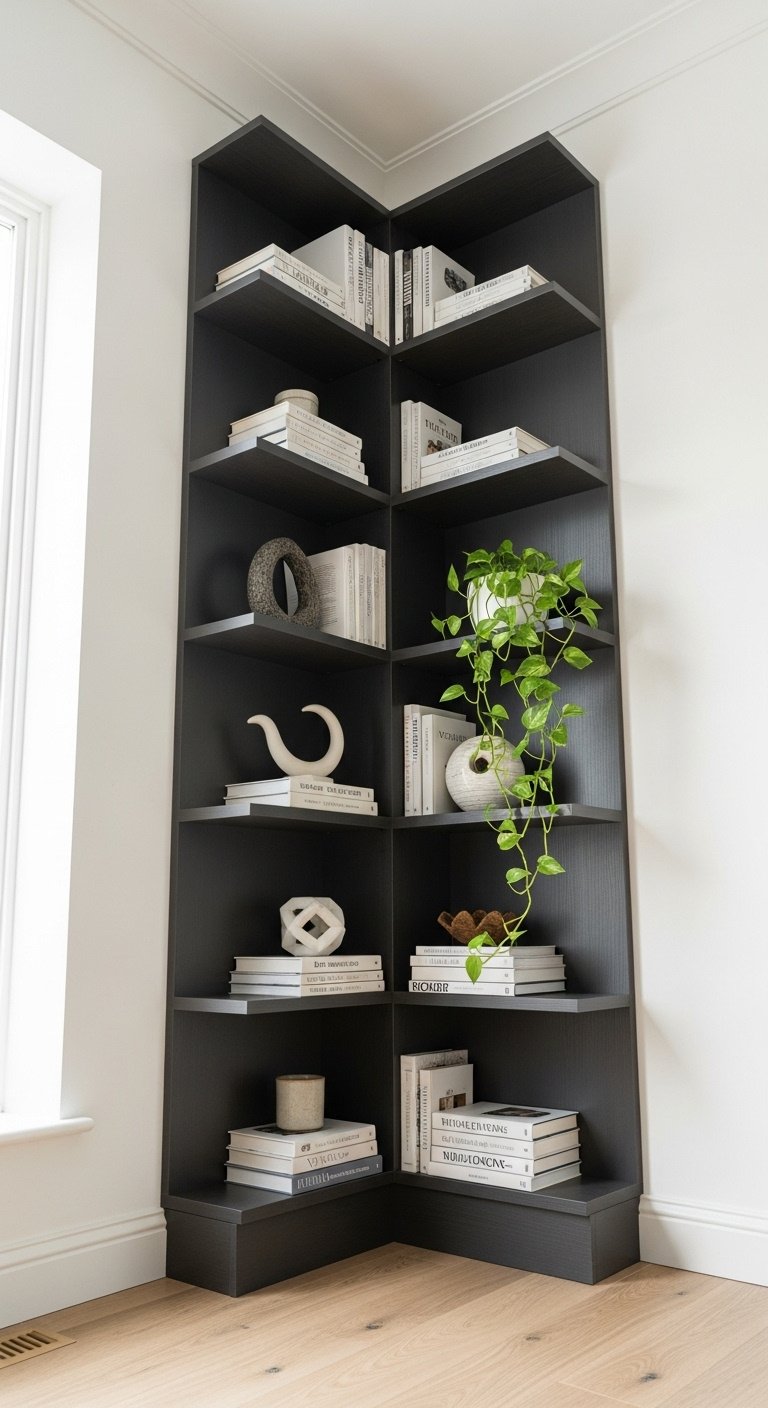
- Materials Needed: Tall bookshelf or floating shelves, stud finder, drill, level.
- Step-by-Step Directions:
- Install Tall Shelving: Choose a tall, narrow bookshelf that reaches toward the ceiling. This draws the eye vertically.
- Hang Curtains High and Wide: Mount your curtain rod 4-6 inches above the window frame and extend it 3-6 inches on either side. Use curtains that go all the way to the floor. This makes the window—and the wall—feel much larger.
- Use Wall-Mounted Storage: Install floating shelves above a desk or TV to get items off the floor and use empty wall space.
- Incorporate Hanging Plants: Hang a plant from the ceiling in a corner to add life and draw attention upwards.
Pro-Tip: When styling tall shelves, leave some empty space. Overcrowding them can defeat the purpose and make the wall feel cluttered. The goal is to create an airy, upward gaze.
Steal this trick to make your room feel taller! Pin it now.
6. Create Flow with Uniform Flooring
One of the most powerful ways to unify an open concept space is to use a single, continuous flooring material throughout. This eliminates visual breaks between the kitchen, dining, and living areas, creating an uninterrupted flow that makes the entire home feel larger and more cohesive.
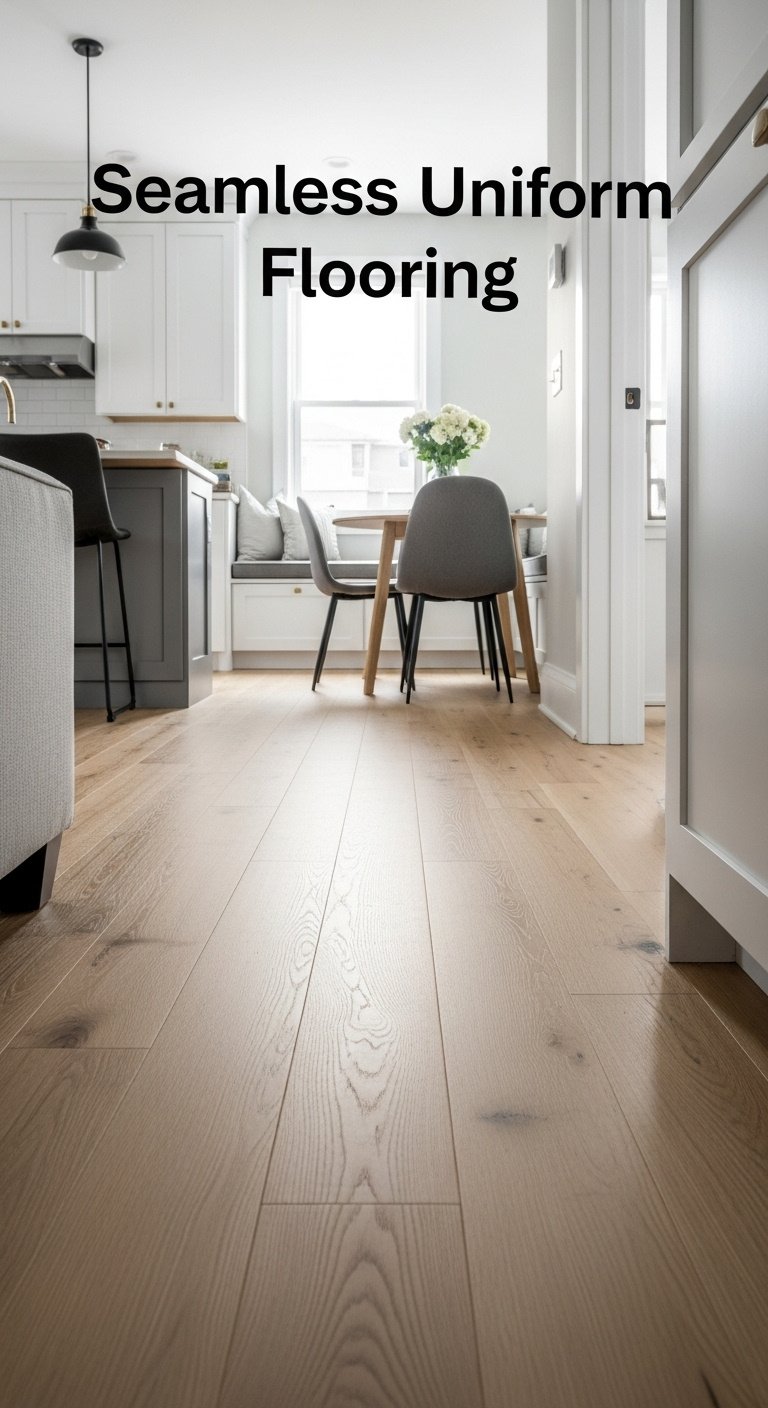
- Materials Needed: Flooring samples (e.g., hardwood, LVP, laminate).
- Step-by-Step Directions:
- Analyze Your Lifestyle: Choose a material that suits all zones. Hardwood is beautiful but requires care. Luxury Vinyl Plank (LVP) is durable and waterproof, making it ideal for both kitchens and living areas.
- Select a Continuous Style: Opt for one single flooring material to run throughout the entire open-plan area. This eliminates visual breaks and makes the space feel like one large, cohesive unit.
- Go Lighter: In small spaces, lighter-colored flooring (like light oak, maple, or a grey wash) reflects more light and enhances the sense of openness.
- Mind the Plank Direction: Lay planks parallel to the longest wall or directed towards the main light source to further elongate the space.
Lesson Learned: If you can’t replace the flooring, you can still create a similar effect. Use large, low-pile area rugs in a similar neutral tone in each zone to cover jarring transitions and create a more unified look.
Pin this fundamental design rule for open spaces!
7. Layer Lighting for Ambiance and Separation
Strategic lighting is crucial for both function and form; layering different types of lighting helps define zones and create specific moods. By using a mix of ambient, task, and accent lighting, you can highlight each area’s purpose while adding warmth and sophistication to the entire space.
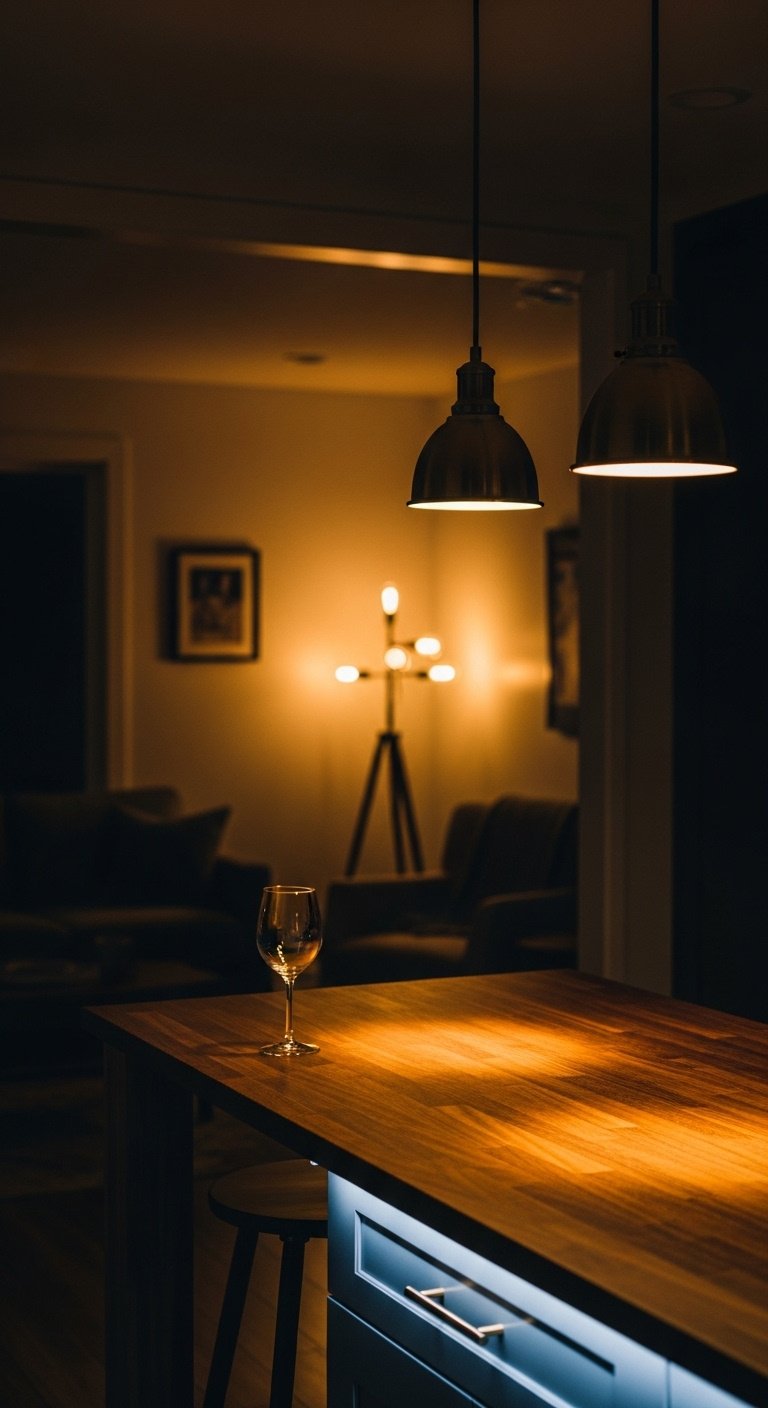
- Materials Needed: Dimmer switches, various light fixtures (pendants, floor lamp, under-cabinet lighting).
- Step-by-Step Directions:
- Start with Ambient: Ensure you have good overall lighting from recessed lights or a central ceiling fixture. Install dimmer switches for full control.
- Add Task Lighting: Focus on functional areas. Install pendant lights over the kitchen island or dining table. Place a reading lamp next to a sofa or armchair. Add under-cabinet lighting in the kitchen for food prep.
- Incorporate Accent Lighting: Use accent lights, like a small spotlight on a piece of art or a plant, to create visual interest and depth.
- Unify with Style: Use fixtures from the same family or with a common finish (e.g., all matte black or brushed brass) across the different zones to maintain a cohesive look.
Pro-Tip: Putting all your lights on dimmer switches is a game-changer. It allows you to brighten the kitchen for cooking, then dim it to create a cozy, relaxing atmosphere in the living area for movie night.
Light up your life! Save this lighting strategy.
8. Embrace Reflective Surfaces to Amplify Light
To make any small space feel bigger and brighter, incorporate reflective surfaces that bounce natural and artificial light around the room. Mirrors, glass, and metallic finishes create an illusion of depth and openness by reducing visual clutter and maximizing luminosity.
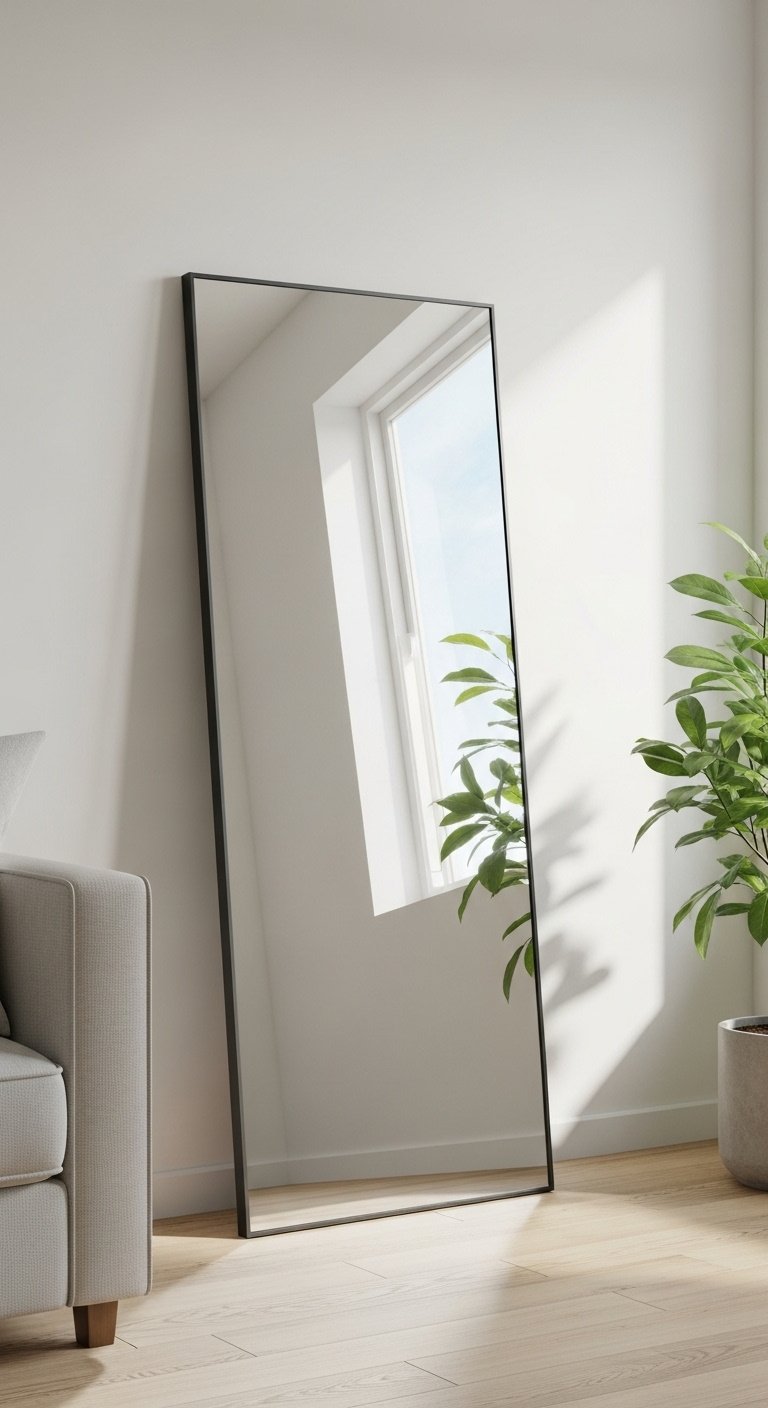
- Materials Needed: Large wall mirror, stud finder, picture hanging kit OR furniture with reflective surfaces.
- Step-by-Step Directions:
- Hang a Large Mirror: Place a large mirror on the wall opposite your main window. It will reflect the natural light and the view, creating an illusion of depth.
- Choose Glossy Finishes: Opt for high-gloss kitchen cabinets or a glossy tile backsplash to bounce light around the kitchen area.
- Incorporate Glass Furniture: A glass coffee table or console table has less visual weight than a solid wood one, making the room feel less crowded.
- Add Metallic Accents: Use decor with metallic finishes like chrome, brass, or polished nickel in lamps, picture frames, and cabinet hardware to add a touch of sparkle and reflection.
Lesson Learned: Don’t overdo it. One or two large reflective pieces, like a big mirror and a glass table, are more impactful than a dozen small, shiny objects which can just look cluttered.
Pin this classic designer trick to make any room bigger!
9. Add Subtle Separation Without Walls
If you crave a bit more definition, use furniture and other elements to create permeable dividers that separate zones without blocking light or flow. These clever solutions offer the best of both worlds: the structure of separate rooms with the airy feel of an open plan.
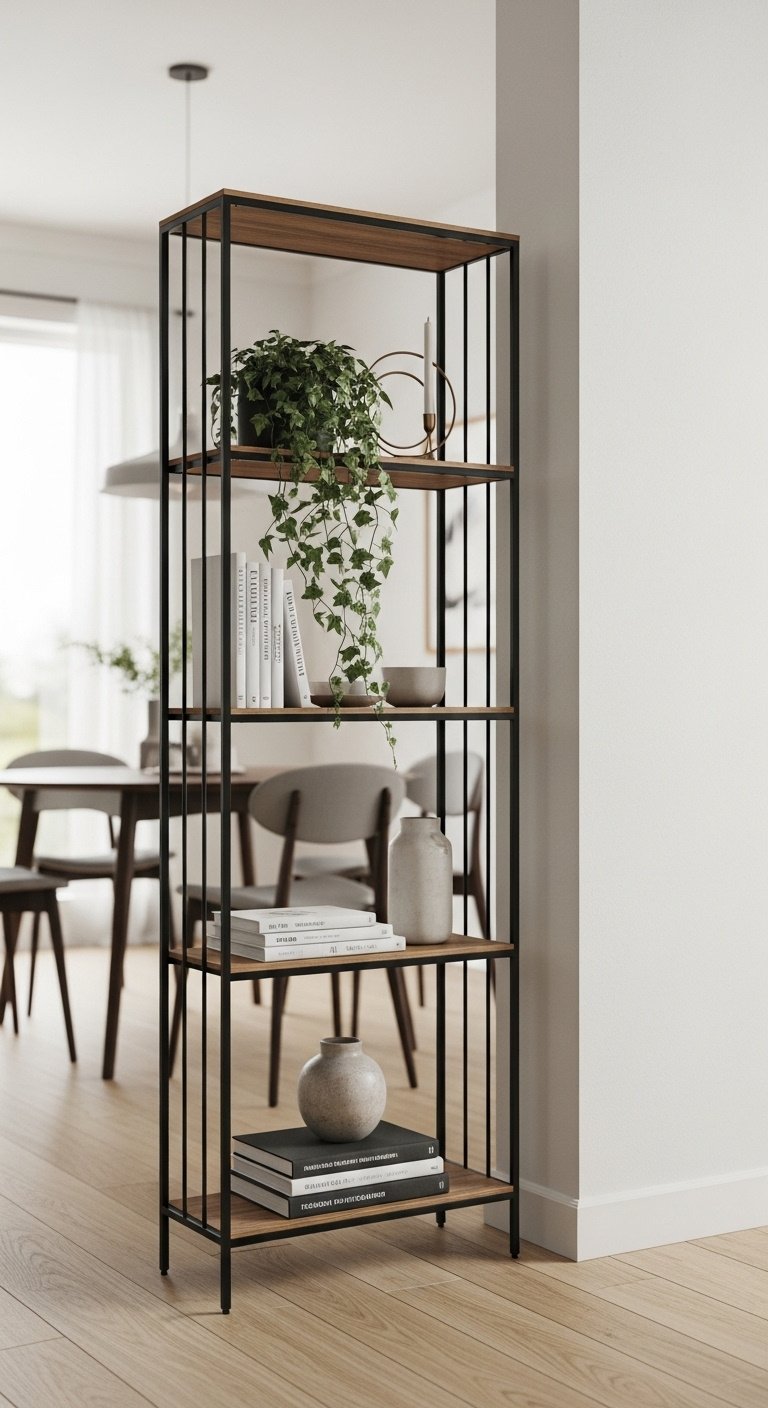
- Materials Needed: Open-backed bookshelf OR a console table.
- Step-by-Step Directions:
- Use an Open Bookshelf: Place a tall, open-backed bookshelf (like an étagère) perpendicular to a wall to create a screen-like effect between the living and dining areas. It defines the space while allowing light to pass through.
- Float Your Sofa: Instead of pushing your sofa against a wall, float it in the middle of the room. Place a slim console table behind it to create a clear boundary for the living room zone.
- Consider a Decorative Screen: A folding decorative screen is a flexible, non-permanent way to hide a messy kitchen view when guests are over or create a cozy corner.
- Install a Half-Wall: For a more permanent solution, a low half-wall with a countertop can act as a breakfast bar and clearly delineate the kitchen without closing it off entirely.
Pro-Tip: When using a bookshelf as a divider, style it minimally with books, plants, and decorative objects. This keeps it feeling light and airy, maintaining the open concept feel.
The perfect compromise! Pin this room divider idea.
Key Takeaways: Your Quick Guide to a Flawless Small Open Floor Plan
- Create Unity: Use a consistent color palette and uniform flooring to make the entire space feel cohesive and larger.
- Define Zones: Use area rugs, furniture placement (like a floating sofa or kitchen island), and layered lighting to create distinct functional “rooms” without walls.
- Maximize Every Inch: Choose multi-functional furniture (storage ottomans, extendable tables) and utilize vertical space with tall shelving to reduce clutter and add function.
- Amplify Light: Incorporate large mirrors, glass surfaces, and glossy finishes to bounce natural and artificial light around the room, making it feel brighter and more expansive.
- Maintain Flow: Any dividers you use, such as open bookshelves or half-walls, should be permeable to light and sight to preserve the open feel.
People Also Ask About open floor plan kitchen dining living
Is an open-plan kitchen living room a good idea for a small space?
Yes, it is an excellent idea. An open plan maximizes the sense of space in a small home by removing walls that block light and create cramped corridors. It enhances natural light, improves traffic flow, and creates a more social, connected environment. The key is to use smart design strategies to define different zones so the space remains organized and functional.
How do you separate a kitchen and living room in a small open floor plan?
You can create separation without walls by using visual cues. A kitchen island or peninsula creates a natural physical and visual boundary. Placing a sofa with its back to the kitchen (floating it) defines the start of the living area. Strategic use of area rugs to anchor each zone and different types of pendant or track lighting over specific areas also creates effective, non-obstructive separation.
Why is open-plan living sometimes considered less popular now?
The trend has shifted slightly due to changes in lifestyle, like more people working from home, which highlighted needs for privacy and noise control. In large open spaces, sounds can travel easily, and distinct, quiet areas for work or relaxation are harder to create. However, for small homes, the space-enhancing benefits of an open plan often outweigh these drawbacks, which can be mitigated with solutions like strategic furniture placement and soft furnishings.
Final Thoughts
Your small open floor plan isn’t a limitation but an opportunity to be creative and intentional with your design. It’s a canvas waiting for you to define its purpose and beauty. By using these ideas to create harmony, definition, and flow, you can craft a space that feels expansive, functional, and uniquely yours.
What’s the first tip you’re excited to try in your home? Let me know in the comments below
